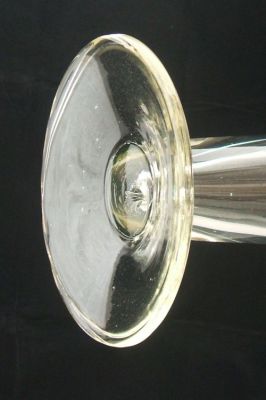Click any image to enlarge.
H. exactly 16" (a standard S&W size) 40.5cm, max rim d. 9" 22.7cm, foot d. 4¼" 10.8cm, w. 2lb 10oz 1190g.
Query 1 â Date
Gulliver p.218 shows S&W "Shaded" colours in use c.1900, and I've seen evidence that S&W "Shaded" colours were being made and sold at a premium over "Plain" colours in the mid to late 1920s â almost a thirty year span. Has anyone seen evidence that would extend this period?
Query 2 â S&W foot attachment
Some years ago I noticed that both flower tubes and trumpet vases by S&W were illustrated with and without strengthening collars at the join of the vase to the foot. At the time it seemed likely that larger vases needed the reinforcement of a collar whereas small vases didn't, and whoever had drawn the illustrations in the S&W trade catalogues had accurately reproduced whatever he had been given to illustrate. This vase doesn't fit that theory â another one bites the dust! 
If you look at the photograph to the right (click it to enlarge it) you will see some peculiarities about this foot. It looks as if extra glass was added below the foot which was spread out almost to the rim. Also you will see a depression slightly off centre. It looks to me as if either the flute was pushed through the foot ring a little too far and the end of the flute reheated or extra glass was added, then a pointed tool used to open up and spread the molten glass.
At the National in May, Nigel kindly pointed out to me that glassmakers have always been very protective of their own skills and techniques. I don't think my original theory was far off. I now think that it wasn't size of the piece that determined the foot attachment technique at S&W, but who had made it.
I would welcome authoritative comment â I'm no glassmaker, merely watching them at work with considerable admiration whenever I get the opportunity. | |  |
Thanks for your interest,
Bernard C.
